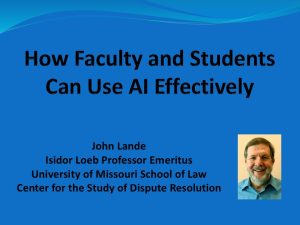This post introduces a new 27-minute video, How Faculty and Students Can Use AI Effectively, which outlines principles for using artificial intelligence in legal education and dispute resolution. It explains how to write effective prompts, assess AI responses, and use these tools responsibly.
The video provides a general introduction to AI, including tips for using tools like ChatGPT in legal education. It identifies several ways faculty and students can use AI productively, for example:
- Faculty can use it to develop teaching materials and streamline preparation.
- Students can use it to explore ideas, get feedback on drafts, and prepare for simulations.
This PowerPoint provides an overview of the video, which includes links to a guide for writing good AI prompts and other resources.
The video features two demonstrations. One shows faculty creating a new simulation from scratch. The other gives suggestions to a student to prepare for a simulated mediation – all in a few seconds. Here’s the chat transcript of these demonstrations.
Helping Students Use AI Responsibly
Even when faculty do not incorporate AI into their courses, many students use it anyway. This video offers guidance to help students do so responsibly. It emphasizes the importance of understanding and complying with institutional AI policies that prescribe what is and is not permitted.
A 2023-2024 ABA study found that 69% of law schools had already revised their academic integrity policies in response to AI.
Some universities already require faculty to include AI policies in every course syllabus – and that number is likely to grow. For example, the University of Missouri policy states:
All instructors of record must adopt an artificial intelligence (AI) policy for their course and state this in their course syllabus.
The statement should include the following:
-
-
- When the use of AI is permitted with attribution.
- When the use of AI is not permitted.
- What are the consequences for misusing AI (refer to academic integrity policy).
- Which AI tools are permitted or not permitted.
-
Even if your school doesn’t require you to include an AI policy in your syllabus, it’s a good idea to clearly tell students what’s acceptable and what’s not. You might also suggest that they watch the video – it’s a quick way to help them learn how to use AI responsibly.
RPS Coach
The video also summarizes RPS Coach – a version of ChatGPT trained on my scholarship in negotiation, mediation, and legal education. Generic AI tools can generate plausible responses on these topics. But RPS Coach draws on decades of my work, offering a deeper and more nuanced understanding.
For more information about RPS Coach, see the RPS Coach Project Library, a short annotated bibliography of pieces about RPS Coach, AI generally, and its use in writing and legal education.
To understand the theory behind RPS Coach, see Promoting Better Dispute Decision-Making with an AI Tool Built on RPS Theory, which will appear in the symposium issue of the Washington University Journal of Law and Policy that Karen Tokarz organized.
Conclusion
When used thoughtfully, AI can enhance students’ learning. To achieve that goal, students need to learn how to use AI tools wisely and responsibly. The video can help them do just that.


